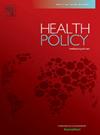Availability of primary care and avoidable attendance at English emergency departments: A regression analysis
IF 3.4
3区 医学
Q1 HEALTH CARE SCIENCES & SERVICES
引用次数: 0
Abstract
Attendances at emergency departments (EDs) by patients who could have been treated in primary care increase waiting times and costs in EDs and may reduce quality of care. This study examines whether the probability that a patient’s ED attendance is avoidable is associated with their characteristics and the quality, staffing, and availability of their general practice, particularly its extended hours provision. We estimate ED attendance level linear probability and logistic regressions using data on 10.16 M attendances at 144 major EDs by patients aged 16 or over from 6668 English practices. We use two definitions of avoidable ED attendance: the NHS definition (non-urgent) and a new wider definition (clinically inappropriate).
9.3 % of attendances were avoidable according to the NHS definition and 21.8 % with our definition. The probability of avoidable attendance was lower for older, female patients, those living in more socioeconomically deprived or sparsely populated areas, or those closer to their practice than to the ED attended. Attendances from practices where a higher proportion of patients get same-day GP appointments, or were aware of early morning extended hours, were less likely to be avoidable. The probability that an ED attendance was clinically inappropriate was about 0.5 % smaller during weekends or evenings when the practice had extended hours but was not associated with the overall provision of extended hours by the practice.
英国急诊科初级保健的可获得性和可避免的出勤率:回归分析
原本可以在初级保健中心接受治疗的病人到急诊科就诊,增加了急诊科的等待时间和费用,并可能降低护理质量。本研究考察了患者在急诊室就诊的可能性是否与他们的特点、质量、人员配备和全科医生的可用性有关,特别是其延长的工作时间。我们使用来自6668个英语实践的144个主要急诊科的10.16万名16岁或以上患者的出勤数据,估计急诊科的出勤水平线性概率和逻辑回归。我们使用两种可避免的急诊就诊定义:NHS定义(非紧急)和一个新的更广泛的定义(临床不适当)。根据NHS定义,9.3%的急诊就诊是可避免的,而我们的定义是21.8%。老年人、女性患者、生活在社会经济贫困或人口稀少地区的患者、或离诊所较近的患者的可避免就诊概率较低。如果有较高比例的患者在同一天接受全科医生的预约,或者知道清晨有延长的时间,那么就不太可能避免就诊。在周末或晚上,当执业时间延长时,急诊室出诊在临床上不合适的概率约为0.5%,但与执业时间延长的总体提供无关。
本文章由计算机程序翻译,如有差异,请以英文原文为准。
求助全文
约1分钟内获得全文
求助全文
来源期刊

Health Policy
医学-卫生保健
CiteScore
6.40
自引率
6.10%
发文量
157
审稿时长
3-8 weeks
期刊介绍:
Health Policy is intended to be a vehicle for the exploration and discussion of health policy and health system issues and is aimed in particular at enhancing communication between health policy and system researchers, legislators, decision-makers and professionals concerned with developing, implementing, and analysing health policy, health systems and health care reforms, primarily in high-income countries outside the U.S.A.
 求助内容:
求助内容: 应助结果提醒方式:
应助结果提醒方式:


